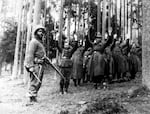
A U.S. soldier of the 12th Armored Division stands guard over a group of Nazi prisoners captured in the surrounding German forest. April 1945.
Office of War Information
The timber industry labor shortage during WWII was very real. Many able-bodied men left the woods to fight in the war and still others felt the pull of wartime manufacturing jobs in cities like Seattle, Tacoma and Portland.
Loggers were exempted from the draft because the United States needed lumber for the war effort. But that didn’t solve the labor shortage.
Like in other war-time industries across the country, women joined the workforce.
“Women do start working [in] the timber industry in the 1940s, particularly in plywood mills,” said UO historian Steven Beda.
In their desperation for timber, the War Labor Board also considered more extreme solutions: German prisoners of war held at several Northwest military installations, including Fort Lawton in Seattle, Fort Lewis near Tacoma, Camp Adair near Corvallis and Camp White near Medford.
“That’s how much they needed lumber,” Beda said. “But the union protested so vehemently that they never went through with this plan.”
